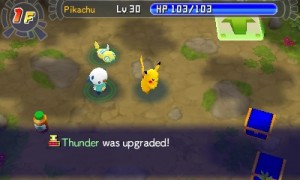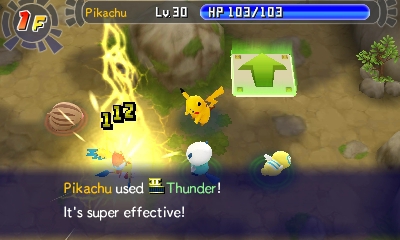Pokémon Mystery Dungeon: Gates to Infinity Review
This game was reviewed on the Nintendo 3DS.
I am, and always will be, an original 151 Pokémon guy. I still enjoy the newer Pokémon games, and do my best to check them out soon after they’re released, but I find they never seem to fill me with the same sense of excitement and wonderment as Red and Blue managed to evoke. Maybe it’s the fact that there are now over 600 Pokémon to deal with, each with different evolutionary chains, types, and locations, or maybe it’s just the fact that I’ve grown older (but not up, never up). While the core of Pokémon games hasn’t changed drastically from the days of Red and Blue, the Mystery Dungeon series of spinoffs mixes up the formula quite dramatically, having players take on the role of a particular Pokémon, and tasking them with dungeon crawling.
Pokémon Mystery Dungeon: Gates to Infinity, developed by Spike Chunsoft, sees players thrust into a world inhabited solely by Pokémon, with the initial task of helping an unknown Pokémon who is in danger. Upon their arrival, however, the player’s character (which can be chosen from a selection of five Pokémon) meets what will soon be their AI companion (chosen from the remaining four Pokémon), who informs them of their plans to build a Paradise for Pokémon, and go adventuring. Joining with the AI companion, the player sets off on a number of different adventures, rescuing Pokémon, hunting down items, and bringing peace and trust to the world. Or eventually they do, anyway, as the game takes a fair amount of time to get going. For the first hour or so of the game, I think I actually managed to have some direct input (other than pressing A to continue conversations) for a maximum of about ten minutes. It’s an incredibly lengthy introduction to the game, and doesn’t really do a whole lot to establish a reason for it to be quite so long. Later points in the game are also filled with meaningless exposition and verbal meandering, but at least these are broken up by a fair amount of adventuring in between times.
 Once you do get past the introduction, Gates to Infinity proves itself to be quite a charming little dungeon crawler. There isn’t the depth here that you’ll find in other rogue-like games, both in terms of combat and dungeon mechanics, but the little that is present is almost perfect for a quick burst of adventuring on the go. In Paradise (which is, in effect, a world hub), players can access the Request Board, which contains a series of jobs for them to complete. Whilst the basis for most of these jobs is fairly repetitive, and almost all of them boil down to you working your way to the end of a dungeon, playing through them is good fun, and most quests are over in 10-15 minutes. Completing quests rewards you with various items, some of which can be used in dungeons, while others go towards building and improving Paradise. This is done by both clearing land, which allows Facilities (read: shops, farms, dojos etc.) to be built, and by recruiting different Pokémon, which either happens as part of the narrative, or by defeating them in battle. Unfortunately, you don’t get to build Paradise into your own personal vision of a utopia, as building locations are pre-assigned, but you do get to choose which buildings go where, and the general look of each area.
Once you do get past the introduction, Gates to Infinity proves itself to be quite a charming little dungeon crawler. There isn’t the depth here that you’ll find in other rogue-like games, both in terms of combat and dungeon mechanics, but the little that is present is almost perfect for a quick burst of adventuring on the go. In Paradise (which is, in effect, a world hub), players can access the Request Board, which contains a series of jobs for them to complete. Whilst the basis for most of these jobs is fairly repetitive, and almost all of them boil down to you working your way to the end of a dungeon, playing through them is good fun, and most quests are over in 10-15 minutes. Completing quests rewards you with various items, some of which can be used in dungeons, while others go towards building and improving Paradise. This is done by both clearing land, which allows Facilities (read: shops, farms, dojos etc.) to be built, and by recruiting different Pokémon, which either happens as part of the narrative, or by defeating them in battle. Unfortunately, you don’t get to build Paradise into your own personal vision of a utopia, as building locations are pre-assigned, but you do get to choose which buildings go where, and the general look of each area.
As you complete various tasks from the Request Board, you are awarded Paradise Points – a form of progression notification that allows you to increase the rank of Paradise. What this essentially does is unlocks extra space for you to build in, and extra Facilities for you to construct, each time you level up. Some of these later Facilities take on the form of minigames, such as Sunken Treasure, which requires you to tilt your 3DS to find rewards, and the Prize Palace, which utilises the 3DS’ touchscreen as a way to uncover prizes on scratch cards. By the end of the game, Paradise is a bustling place, full of various shops and activities, and packed with different Pokémon who have opted to join you.
 Adventuring takes place in a 2D-isometric viewpoint, with dungeons made up of a variety of straight tunnels and larger rooms. Aside from artistic differences in the texturing, most dungeons are indistinguishable from one another, making the random generation of each dungeon fairly pointless. Every dungeon is characterless, and they eventually merge into one in your mind. It would almost have been better to have a limited number of dungeons, each with their own distinctive flavour, than have an unlimited supply of boring corridors and mundane openings.
Adventuring takes place in a 2D-isometric viewpoint, with dungeons made up of a variety of straight tunnels and larger rooms. Aside from artistic differences in the texturing, most dungeons are indistinguishable from one another, making the random generation of each dungeon fairly pointless. Every dungeon is characterless, and they eventually merge into one in your mind. It would almost have been better to have a limited number of dungeons, each with their own distinctive flavour, than have an unlimited supply of boring corridors and mundane openings.
Combat inside the dungeons is turn-based, with moves selected in a similar way to that of the core Pokémon games. Each Pokémon has four moves to changes from, which can be switched around as they level up, and vary between offensive moves and statistic modifiers. Although you eventually travel through each dungeon as a team of four Pokémon, you’ll begin to find that a lot of your fights take place within the corridors of each dungeon, as opposed to the wider rooms. What this means is that most battles take on the form of your personal Pokémon defeating waves of enemy Pokémon one at a time due to space restrictions, rather than the wide-ranging battles that could otherwise have played out. This makes the three Pokémon that stand idly behind your avatar rather redundant, almost to the point of purposelessness.
What Gates to Infinity does get right, however, is in its drip-feeding of information, even if it does come across as a little slow and patronisingly heavy-handed at times. Your team slowly grows from your initial duo into a foursome, the particulars of building Paradise, such as clearing land and upgrading buildings are easily broken down into chunks and explained thusly, and even the weather system, which affects the strengths and weaknesses of different Pokémon, is explained almost six hours into the game. For younger players, or even for those playing in fits and starts, the game makes a strong point of not overwhelming you with information that isn’t necessarily always pertinent to the task at hand. There’s no need to worry about becoming lost in the narrative either, as, once the initial dialogue-heavy sequence is out of the way, the vast majority of the game is left to the player to decide how to move forward – aside from short sequences dotted throughout various post-dungeon segments.
Pokémon Mystery Dungeon: Gates to Infinity packs a huge amount of content into its cartridge, with plenty of dungeons to explore, and many quests to fulfil, even if a lot of the time they do look and feel very similar. This is added to by Magnagates, which – according to the back of the box – are found in real-world locations (so long as they are round) by scanning them with the 3DS’ camera. In reality, this function is more finicky than useful, as finding the exact light conditions, distance from the object and correct colouring to be picked up by the camera takes almost as long as the dungeon itself. These dungeons are optional, and their type varies, depending on the colour of the object that you scanned. However, they are certainly useful, as any money or items that you find within these dungeons is transferred to your character within the main mode of the game. It’s an admirable and intriguing idea, but one that unfortunately doesn’t pay off quite as well as you’d have hoped.
 Whilst it is true that Gates of Infinity contains a wealth of content, it is also true that it will take a great deal of willpower on behalf of players to see all of it. Due to the repetitive nature of the quests and environments, coupled with an almost non-existent story, the game doesn’t really inspire any drive in its audience to see what’s just around the corner, as chances are you’ve already seen it. This latest iteration of the Mystery Dungeon games isn’t bad by any stretch of the imagination, it’s just one of those games where you come out of a play session and almost can’t remember what you just did within the game, as it all starts to blur into one long slog. Admittedly, the game doesn’t seem quite so monotonous if you play in small doses, as handheld games often are, and most of the dungeons seem purposefully built for a quick half-hour of play here and there. Gates of Infinity does have its issues, but it also provides a solid, if uninspiring, taste of Pokémon adventuring.
Whilst it is true that Gates of Infinity contains a wealth of content, it is also true that it will take a great deal of willpower on behalf of players to see all of it. Due to the repetitive nature of the quests and environments, coupled with an almost non-existent story, the game doesn’t really inspire any drive in its audience to see what’s just around the corner, as chances are you’ve already seen it. This latest iteration of the Mystery Dungeon games isn’t bad by any stretch of the imagination, it’s just one of those games where you come out of a play session and almost can’t remember what you just did within the game, as it all starts to blur into one long slog. Admittedly, the game doesn’t seem quite so monotonous if you play in small doses, as handheld games often are, and most of the dungeons seem purposefully built for a quick half-hour of play here and there. Gates of Infinity does have its issues, but it also provides a solid, if uninspiring, taste of Pokémon adventuring.
Pokémon Mystery Dungeon: Gates to Infinity scores a 3.75 out of 5
About This Post
